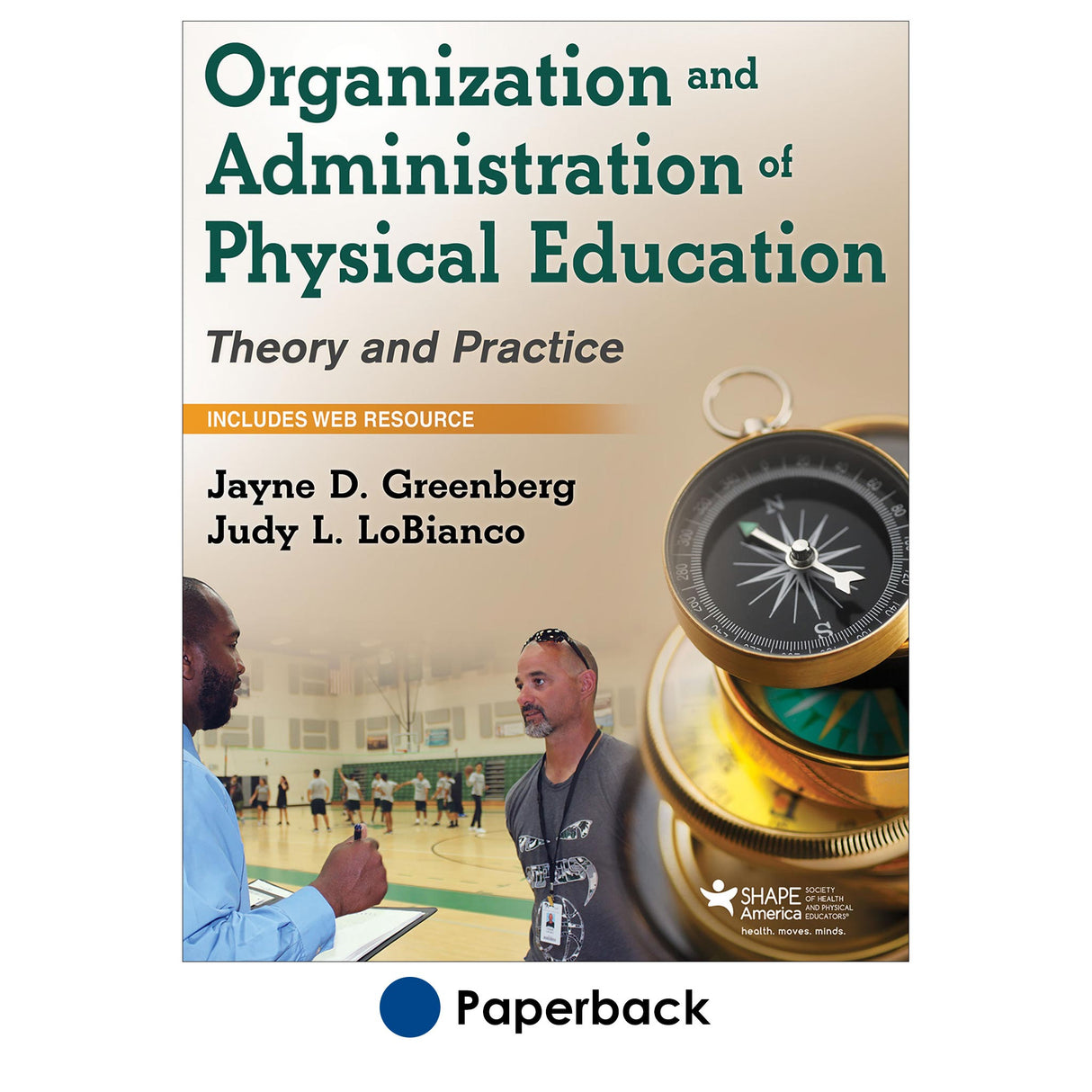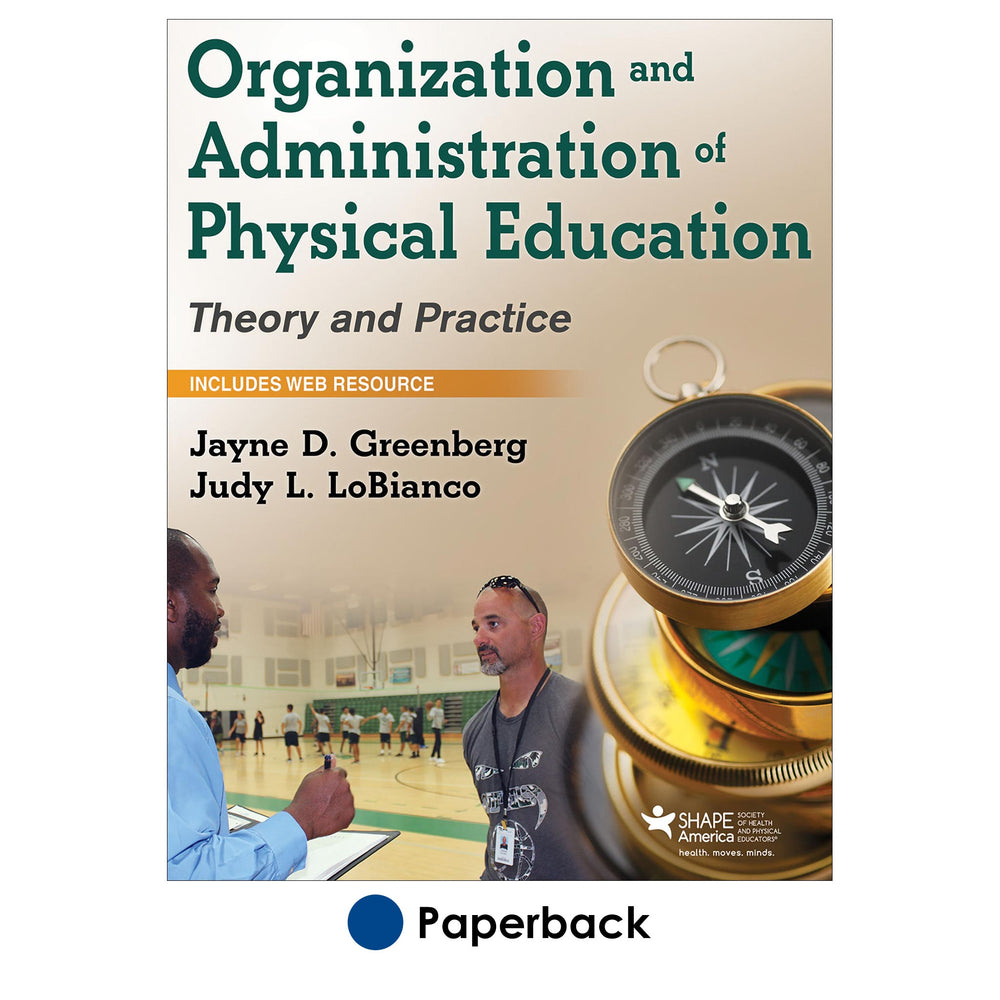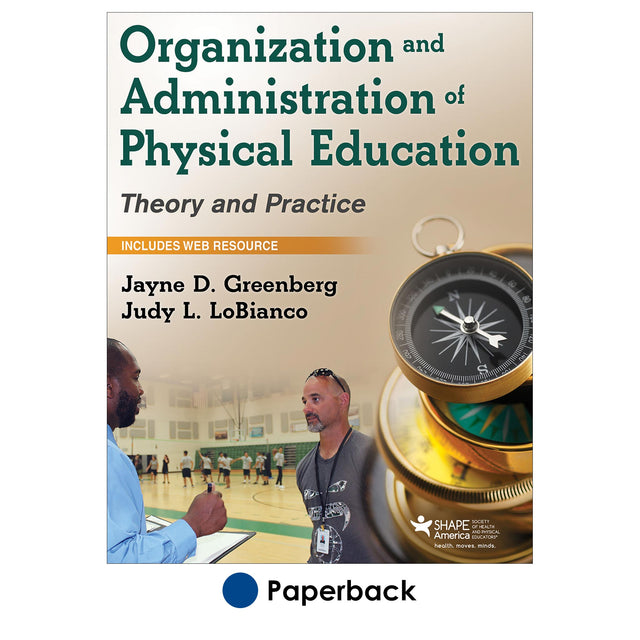Organization and Administration of Physical Education With HKPropel Access
Theory and Practice
Author: Jayne D. Greenberg, Judy L. LoBianco
$69.00 CAD
If you want to know how to be the best, you learn from the best.
Two SHAPE America Physical Education Administrators of the Year share what it takes to be an outstanding administrator in Organization and Administration of Physical Education: Theory and Practice.
Jayne Greenberg and Judy LoBianco, veteran leaders in the field with decades of successful administration experience, head a sterling list of contributors who have taught at the elementary, middle school, high school, and college levels in urban, suburban, and rural settings. Together, these contributors expound on the roles and responsibilities of physical education administrators through both theoretical and practical lenses.
The result is a book that will be highly useful to undergraduate students looking to enter the field, as well as a resource for administrators in physical education leadership positions who are looking to acquire new skills and innovative ideas in each of the five areas of responsibility covered in the book.
Part I covers leadership, organization, and planning. It explores leadership and management styles and presents practical theories of motivation, development, and planning. It also looks at how to plan for the essential components of an effective, quality physical education program. In part II, readers examine various curriculum and instruction models and navigate through curriculum theory and mapping. This section also offers guidance on planning events, including special programs and fundraising projects, and how to build a team and secure community connections for those special events.
Part III helps administrators plan and design new school sites or renovate existing ones, and it presents contemporary concepts in universal design and sustainable environmental design. It also offers ideas on how to incorporate technology to meet the needs of 21st-century learners, including the use of social media and robotics in delivering instruction and communication. Part IV explores written, verbal, and electronic communication issues, as well as legal and human resource issues. Administrators learn how to lobby and advocate for physical education, how the legal system affects schools, and how to examine personnel issues, bullying, and harassment.
Part V explains the fiscal responsibilities inherent in administrative positions, including budgeting, bidding, and purchasing. It also shows how administrators can secure funding independent of district or local funding, offering many examples of grants and fundraising opportunities with sample grant applications.
Throughout the text, special features—Advice From the Field and Leadership in Action—share tips, nuggets of wisdom, and examples of administrators excelling in their various responsibilities. The book also comes with many practical examples of forms that are useful in carrying out responsibilities, and each chapter offers objectives, a list of key concepts, and review questions to facilitate the learning. In addition, the text has related online resources consisting of supportive materials and documents.Organization and Administration of Physical Education: Theory and Practice, published with SHAPE America, offers the solid foundational theory that administrators need and shows how to put that theory into daily practice.
Human Kinetics is proud to publish this book in association with SHAPE America, the national organization that defines excellence for school-based health and physical education professionals across the United States.
Note: A code for accessing HKPropel is included with all print books.
Audience
Textbook for upper-level undergraduate and graduate courses in organization and administration of physical education. Reference for physical education administrators.
Part I. Leadership, Organization, and Planning
Chapter 1. The Role of a Physical Education Administrator as a Leader
Jayne D. Greenberg and Judy L. LoBianco
Roles and Responsibilities of the Physical Education Administrator
Leadership Versus Management
Leadership Defined
Characteristics of Effective Leaders
Developing Leaders
Understanding Your Philosophy of Leadership
Determining Your Leadership Style
Theoretical Approaches to Leadership
Power, Authority, and Influence
Motivation Theories of Leadership
Strategic Planning
Ethical Leadership
Conflict Resolution
Diversity in Leadership
Conclusion
Chapter 2. Management and Operations
Jayne D. Greenberg
Management Theories
Management Skills and Competencies
Roles and Responsibilities and Administrative Functions
Change Theory
Day-to-Day Operations
Teachers as Leaders
Physical Activity Leader Training
Conclusion
Chapter 3. Organizing and Planning a Quality Physical Education Program
Jayne D. Greenberg and Judy L. LoBianco
Definition of Physical Education
Benefits of a Quality Physical Education Program
Program Planning
Essential Components of Physical Education
Program Planning Considerations
The School and Community Connections National Framework: Comprehensive School Physical Activity Plan
The Whole School, Whole Community, Whole Child Model
Conclusion
Part II. Curriculum, Instruction, Assessment, and Special Events
Chapter 4. Curriculum Development and Evaluation
Nichole D. Calkins, Jayne D. Greenberg, and Lori S. Dunn
The Curriculum Development Process
Understanding Standards-Based Curriculum Design
The Planning Phase
The Design Phase
The Implementation Phase
The Evaluation Phase
Conclusion
Chapter 5. Quality Instruction
Nichole D. Calkins, Sheri J. Brock, Leah H. Robinson, Jayne D. Greenberg, and Kara K. Palmer
Appropriate Instruction
Factors That Influence Quality Instruction and Environment
Conclusion
Chapter 6. Teacher Evaluation
Miriam Kenyon, Kathleen Satterley, Jayne D. Greenberg, and Judy L. LoBianco
Teacher Evaluation Models
Perception of Evaluation
Developing a Growth Mindset
Components of Teacher Evaluation
Teacher Observation
Conclusion
Chapter 7. Event Planning and Special Programs
Jayne D. Greenberg
Conducting Community-Wide Events
Conducting Schoolwide Events
Before- and After-School Programs
Conclusion
Part III. Facilities, Equipment, and Technology
Chapter 8. Facilities, Design Criteria, and Equipment
Christopher Hersl and Jayne D. Greenberg
Defining the Purpose of a Facility
Construction of a New Facility
Planning Facilities
Role of the Planning Committee
Design Standards, Universal Design, and Sustainable Design
General Considerations for Physical Education Construction Projects
Indoor Facilities
Wellness and Fitness Centers and Weight Training Rooms
Outdoor Facilities
Shared Facilities
Conclusion
Chapter 9. Technology in Physical Education
Collin Brooks, Richard Benvenuti, and Jayne D. Greenberg
The Importance of Technology in Education
Understanding the 21st-Century Learner
Technology Infrastructure
Integrating Technology in a Physical Education K-12 Setting
Technology for Instructional Use
Innovative Uses of Technology
Teacher Management: Assessment Strategies With Mobile Devices
Creating Visuals for Physical Education
Digital Professional Development
Online Learning: Managing Participation in Online Learning Professional Development
Online Physical Education Courses and Virtual Learning
Developing a Digital Professional Learning Community
Keeping Up With Technology
Conclusion
Part IV. Communication, Legal Issues, and Human Resources
Chapter 10. Communications, Internal and External Public Relations, and Advocacy
Carly Wright, Jayne D. Greenberg, and Judy L. LoBianco
Effective Communication
Formal and Informal Organizational Communication: The Flow of Communication
Elements of Effective Communication
Methods of Communication
Public Relations
Advocacy
Conclusion
Chapter 11. Legal Issues in Physical Education
Jessica de Koninck, Shawn Ladda, Judy L. LoBianco, and Jayne D. Greenberg
Federal and State Legislation
Liability in Physical Education
Legal Issues and Lesson Planning
Substitute Teachers
Searches, Seizures, and Locker Privacy
Bullying, Harassment, and Sexual Harassment
Title IX
Transgender Legal Issues in Physical Education
Facility Signage
Conclusion
Chapter 12. Human Capital Management
Lauren O'Mara and Jayne D. Greenberg
Recruiting Talent
Onboarding and Orientation
Induction, Training, and Mentoring for Teacher Retention
Professional Development
Performance Management
Working With Labor Unions
Conclusion
Part V. Financial Management
Chapter 13. Fiscal Management
Jayne D. Greenberg
Understanding District Budgets
The Budget Process
Expenditure of Funds: Purchasing Process
Working With Vendors
Bid Process
Audits
Travel and Meal Reimbursement
Conclusion
Chapter 14. Grant Writing and Outside Funding
Alexandra M. Reyes and Jayne D. Greenberg
Securing Local Funding: Dipping Into Discretionary Accounts
Securing and Developing Business Partnerships
Fundraising
Securing Funding Through Grants
Conclusion
All ancillaries are free to adopting instructors through HKPropel.
Instructor guide. Includes a syllabus, answers to the chapter review questions from the book, suggested readings, and tips for presenting important key concepts.
Test package. Includes 20 multiple-choice questions for each chapter of the book. The files may be downloaded for integration with a learning management system or printed as paper-based tests. Instructors may also create their own customized quizzes or tests from the test bank questions to assign to students directly through HKPropel. Multiple-choice and true-false questions are automatically graded and student scores can be reviewed by instructors in the platform.
Presentation package. Includes a comprehensive series of PowerPoint slides for each chapter, for a total of over 300 slides.
Instructors also receive access to all student materials in HKPropel. For Organization and Administration of Physical Education, this includes supportive materials and documents.





